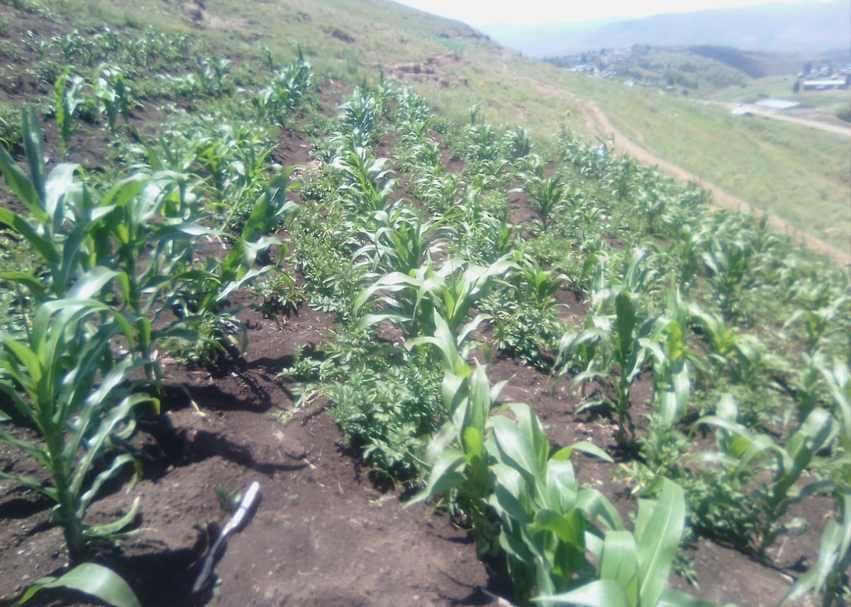The dawn breaks slowly over the jagged mountains of Thaba-Tseka. Mist coils over the valleys like smoke and the early light paints the terraced hills in shades of gold and green.
It’s a breath-taking view from the eyes of a visitor, but for those who farm this rugged landscape, beauty often hides a deeper struggle.
Here, where Lesotho’s heart beats closest to the sky, farmers face the daily battle of surviving the changing climate.
Thaba-Tseka’s sits approximately 2,200 (7,218 feet) meters above sea level and every season brings new challenges; sudden frost, long dry spells, pounding rain that strips the hills bare. Yet, against these odds, the farmers of Thaba-Tseka continue to plough, plant and persevere.
Agriculture in Thaba-Tseka has always been defined by its geography.
The district’s mix of icy highlands, steep mountain slopes and the warmer Senqu River valley offers both opportunities and harsh limitations. The high altitude gives life to cool-weather crops, but the same mountains make mechanised farming nearly impossible.
Makhema Phohleli, a small-scale farmer from Thabong village, explains the difference.
“In the flat fields, farmers can use machinery and plant more, but in the mountains, we use oxen and hand tools because the land is too steep. Planting by hand is hard, and when heavy rain falls, the soil is washed away along with what’s planted,” he says.
Erosion is an old enemy in Thaba-Tseka, but climate change has made it worse. Phohleli notes that when the rains come, they come violently cutting deep gullies through fields and carrying away precious topsoil. When they stop, the earth bakes hard and dry.
“Sometimes the whole fields disappear after a storm with no trace of where ploughing was done.”
“These slopes are so steep that transporting manure or harvesting food is a struggle,” Phohleli adds.
To fight back, he has built terraces of stone-lined steps that hold the soil and moisture.
He uses organic manure and barley rotations to restore fertility.
“I have planted barley so many times just to improve my soil’s fertility and quality and it actually works,” he says proudly.
Phohleli indicates that in Thaba-Tseka, success depends on knowing where and what to plant, saying farmers have learned that the cold, wind-whipped ridges favours wheat and maize, while the milder slopes are better for beans, pumpkins and cabbage.
“Potatoes and maize used to do well here previously but not anymore. The weather has changed too much that to succeed in yield, one needs to adapt. I have learned to read the sky and to choose crops that can survive,” he explains.
This shift in knowledge; from tradition to adaptation, is part of a broader story across Lesotho’s highlands farming.
As weather patterns grow more erratic, Phohleli says they are experimenting with shorter-maturing varieties, intercropping and organic practices.
“We are also combining old wisdom with new tools. Some of us have installed shade nets to protect vegetables from frost and hail; others use plastic tunnels to extend the growing season.
“Farming here has always been a test, but we keep trying, learning and sharing. Our land still has a lot to give but only if we love and care for it enough,” he says.
Phohleli indicates that the signs of climate change are now woven into their daily life; “winters have become longer and harsher, shortening the growing season and freezing crops that once survived the cold. Summers, meanwhile, bring unexpected heat waves and violent storms. The once-reliable patterns of rain have vanished.
“Some years it arrives early and washes away seedlings; other years it disappears for months. We plant, we lose and replant all over again gambling against a climate that no longer keeps its promises,” he says.
These shifting conditions are also changing what people eat.
Phohleli notes that beans and barley, once backup crops, are now staples, replacing maize in many households.
Like in other districts, livestock is both wealth, security, pride and heritage, but even the kraal is not safe anymore.
Tsele Mohoshela, who runs Merino Holdings Farm, describes the twin threats of theft and wildlife as top of their challenges.
“As a registered farmer, my animals cannot graze freely, so I hire people to watch them,” he says.
“…but sometimes those workers steal and sell them far away.”
“These are some of challenges we face coupled with effects of drought and diseases outbreaks,” he says.
Situated high above sea level, Mohoshela describes Thaba-Tseka a rioe place for wildlife attractions, saying foxes have become another persistent danger.
“Foxes eat our animals when they do to the veldts. We have tried dogs and shelters, but they always find a way to come and ravage our animals.”
For many farmers, the fear of theft and predators is constant. Some have started fencing their properties or forming community patrols, but few can afford the materials or manpower to guard herds day and night.
Mohoshela notes that animals like crops, access to water plays a pivotal role in their nurturing, but Thaba-Tseka has experienced severe droughts that left natural water sources dry.
“Due to our distance from Maseru where access to help is easy, we make a way to continue.”
Mohoshela stresses that even when their production is bumper, the isolation of Thaba-Tseka limits market access.
“Poor road networks and distance from urban centres make it costly to transport goods closer to customers. I have many chicken layers and many eggs, but no market,” says Mohoshela in frustration.
He adds, “We were told schools would buy from us, but those promises disappeared. Now I’m breaking eggs and mixing them with animal feed because I can’t sell them off.”
This disconnection leaves farmers trapped in cycles of waste and loss. When prices drop or buyers vanish, the effort of farming feels in vain.
“Sometimes it feels like we farm for the joy of it, but we cannot eat joy. We do this to grow from small scale,” Mohoshela admits bitterly.
Phohleli says beneath this hardship, a collaboration has let them forward.
He explains that farmers are working together, sharing resources and learning new methods as a collective.
“We have formed informal local cooperatives that we use to access seeds and other inputs. Among things we do is to rotate pastures to prevent overgrazing while we are managing our environment,” he says, adding harsher winters make it difficult for animals to find grass.
“We have learned to procure as a unit, to properly store fodder and even make fodder by drying grass in summer and keep it for winter.”
These simple but vital practices are acts of resilience in a district where development projects rarely reach the mountain peaks.
“Despite these hardship, farming in Thaba-Tseka is still a source of joy and a rhythm of life that connects families with their land and ancestors.
“Farming in Thaba-Tseka is a labour of love. Every morning I wake up to birds singing and the sun rising over the mountains. The terrains are hard, but that’s what makes it rewarding. When I see a crop grow after a long season, I feel peace,” Phohleli says softly.
The Broader Picture: Lesotho’s Climate Warning
Thaba-Tseka’s story is not an isolated one — it is a reflection of a national crisis of food insecurity.
The Lesotho Vulnerability Assessment Committee (LVAC) and Integrated Phase Classification (IPC) analysis warn that changing rainfall patterns, pest outbreaks, and heat stress are undermining food production countrywide.
The latest IPC report projects that 334,000 Basotho will face crisis-level food insecurity by early 2026, up from 258,000 in 2025.
The causes are familiar to Thaba-Tseka farmers: crop failure, livestock losses and rising food prices.



